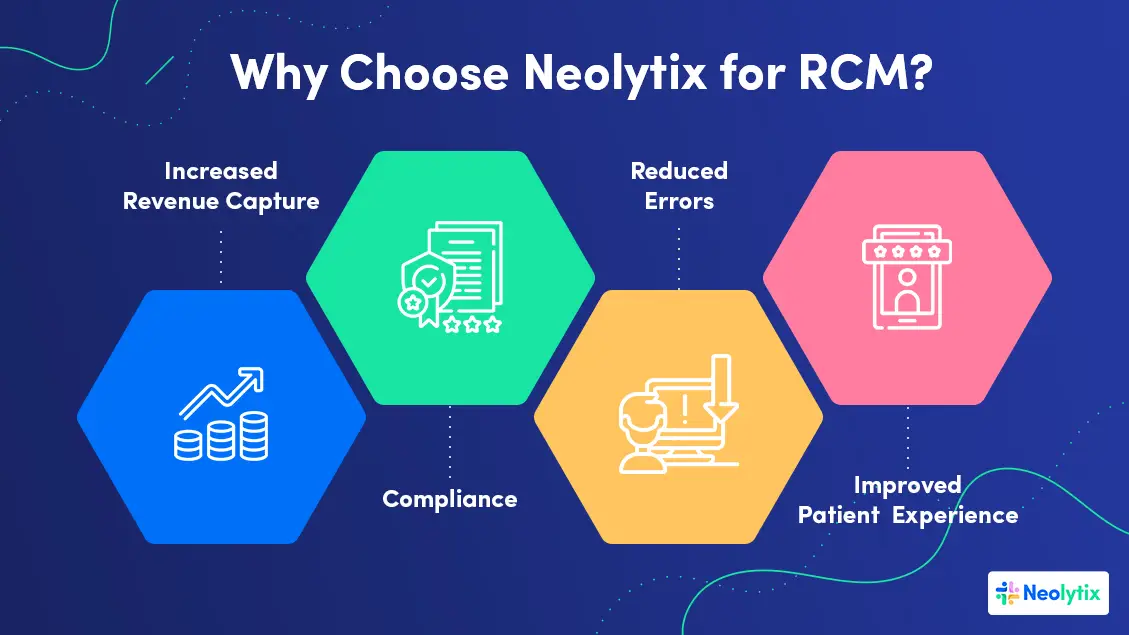- Contact Us +1 224 529 4400
- Schedule A Free Consultation
What is Revenue Cycle Management for Healthcare Providers?
Revenue cycle management (RCM) for healthcare providers refers to the process of managing the financial aspects of a patient’s visit to a healthcare facility, from appointment scheduling to claims processing and payment collection. It covers everything from a patient’s initial appointment to the final payment approval by the payor.
The RCM revenue cycle management process involves multiple steps, including submitting medical billing claims to insurance companies, assigning appropriate medical codes to procedures, converting medical services into billable charges, and collecting payments from patients for any outstanding balances. Further details about the revenue cycle management process are provided later in the article.
What is the Difference Between Revenue Cycle Management and Medical Billing?
Take a load off, grab a beverage, and watch our video explaining the difference between medical billing and revenue cycle management. If you’re in a rush, just scroll past and continue reading below.
Medical billing is the process of submitting medical claims to insurance companies for reimbursement of services rendered to patients, while revenue cycle management encompasses the entire process of managing and optimizing the financial aspects of a patient’s healthcare experience, from appointment scheduling to collecting payment for services rendered.
Medical billing is one of the steps of revenue cycle management in healthcare, but RCM also involves other functions such as patient registration, eligibility verification, charge capture, and denial management. In short, medical billing and revenue cycle management are interconnected, with medical billing being a subset of RCM.
What are the 13 Steps in Revenue Cycle Management?

Revenue cycle management (RCM) is a crucial process for healthcare providers that involves managing the financial aspects of a patient’s visit from appointment scheduling to payment collection. The 13 steps in revenue cycle management in healthcare are essential to ensure that healthcare providers receive timely payments for the services they provide.
1. Patient Pre-registration
At the start of the revenue cycle, patient pre-registration sets the foundation by collecting crucial demographic and insurance information. This step involves capturing and verifying patient data before the actual care encounter, ensuring accurate billing and seamless financial transactions.
Consider incorporating automated systems for data accuracy, minimizing errors, and streamlining the process. Additionally, implement periodic training for staff to stay updated on the latest data collection practices.
2. Appointment Scheduling
Streamlining appointment scheduling is a pivotal step in the hospital revenue cycle management process. Efficient scheduling ensures optimal resource utilization and minimizes no-shows, contributing to the financial health of healthcare organizations. This step involves coordinating and organizing patient visits for various services.
Consider implementing reminder systems to reduce no-shows and enhance patient adherence to appointments. Additionally, analyze appointment data to identify peak times for better resource allocation.
3. Insurance Verification
Verifying insurance is part of the revenue cycle step of patient pre-registration. This process is crucial for eligibility verification, setting the stage for accurate billing and optimal revenue flow. Insurance verification involves confirming the patient’s coverage and benefits before services are rendered.
To enhance this step, invest in real-time insurance verification tools for immediate confirmation and reduced claim denials. Regularly update insurance verification protocols to adapt to changing insurance landscapes.
4. Point-of-Service Collections
Enhancing revenue cycle operations, point-of-service patient collections involve collecting co-pays and outstanding balances during the patient visit. This step contributes to robust accounts receivable management. It means collecting payments directly from patients at the time of service.
A suggestion for improvement is to implement transparent communication on costs, facilitating smoother collections at the point of service. Additionally, explore options for providing payment plans to ease financial strain on patients.
To enhance this step, invest in real-time insurance verification tools for immediate confirmation and reduced claim denials. Regularly update insurance verification protocols to adapt to changing insurance landscapes.
5. Charge Capture
Accurate charge capture, or charge entry, is a linchpin in the revenue cycle, ensuring that all billable services are appropriately recorded. This step is integral to efficient claims processing and revenue cycle medical billing optimization. Charge capture involves accurately documenting and translating the services provided into billable codes.
To improve, conduct regular audits to identify any missed charges or coding discrepancies. Additionally, implement a feedback loop between coding teams and service providers to enhance accuracy in charge entry.
6. Coding and Documentation
Performed by skilled coding teams, medical coding revenue cycle management translates medical services into standardized CPT, ICD codes and modifiers. Accurate coding is essential for efficient claim submission and reducing the likelihood of denied claims. Coding and documentation involve assigning appropriate codes to medical procedures and diagnoses.
Consider ongoing training and regular coding audits to maintain accuracy amidst evolving coding guidelines. Additionally, explore the use of artificial intelligence tools to assist coding teams and enhance efficiency.
7. Claim Submission
Timely and accurate claim submission to payors, like Medicare, Medicaid, United, etc. is a critical step in healthcare revenue cycle management. This process accelerates reimbursement, minimizing revenue leakage and fostering financial health. Claim submission is the act of sending bills to insurance providers or government programs for services rendered.
Improve this step by automating claim submission processes to reduce manual errors and expedite reimbursement. Additionally, monitor claim submission timelines and identify areas for further acceleration.
8. Claim Rejections and Denials Management
Effectively managing claim rejections and denials is a proactive step in revenue cycle operations. Promptly addressing issues ensures optimal revenue recovery and financial stability. Claim rejections and denials management involve identifying and resolving issues that lead to rejected or denied claims.
Enhance this step by implementing robust denial tracking systems and conducting root cause analyses for continuous improvement. Additionally, establish a feedback loop between denial management teams and service providers for preemptive issue resolution.
9. Payment Posting
Accurate and timely payment posting is essential for maintaining up-to-date financial records. This step contributes to efficient accounts receivable management and overall revenue cycle effectiveness. Payment posting involves recording and tracking payments received from payors and patients.
Consider automation for payment posting to reduce manual errors and accelerate reconciliation processes. Additionally, implement regular reconciliation audits to identify and rectify discrepancies promptly.
10. Patient Statements and Follow-Ups
Patient statements and proactive follow-up on outstanding balances are vital for patient care and financial stability. Clear communication in this step ensures patient accountability and satisfaction. Patient statements and follow-ups involve communicating billing information to patients and addressing any outstanding financial obligations.
Improve this aspect by implementing patient-friendly billing statements and utilizing automated communication for follow-ups. Additionally, establish a dedicated patient support team for addressing billing inquiries promptly.
11. Denials Analysis and Appeals
Analyzing denials and conducting appeals contribute to the revenue cycle step of continuous improvement. Identifying patterns ensures efficient claims processing and minimizes revenue loss. Denials analysis and appeals involve investigating the reasons for claim denials and taking corrective actions.
Enhance this step by implementing data analytics tools to identify trends and proactively address potential issues. Additionally, establish a cross-functional denials task force for comprehensive issue resolution.
12. Compliance and Auditing
Compliance and auditing are imperative for maintaining industry standards in revenue cycle management. This step ensures adherence to regulations and identifies areas for enhancement in healthcare revenue cycle operations. Compliance and auditing involve assessing and validating adherence to legal and regulatory requirements.
Improve this step by conducting regular compliance training and embracing advanced auditing technologies for thorough assessments. Additionally, engage external audit firms periodically to gain an unbiased perspective on compliance measures.
13. Financial Reporting and Analysis
Regular financial reporting and analysis provide insights into revenue trends, supporting informed decisions for continuous improvement in healthcare revenue cycle management. Financial reporting and analysis involve reviewing and interpreting financial data to inform strategic decisions.
Enhance this step by incorporating predictive analytics tools for proactive decision-making and strategic planning. Additionally, establish a dedicated financial analysis team to interpret complex financial data and provide actionable insights for organizational improvement.
Conclusion
Achieve Financial Excellence with Neolytix: Your Partner in RCM
Mastering the 13 steps of healthcare revenue cycle management is crucial for ensuring the financial well-being of healthcare organizations. This holistic approach is designed to optimize the flow of revenue, minimize inefficiencies, and elevate operational excellence in the ever-evolving realm of medical billing and service provision.
For in-depth insights into professional RCM services and strategies to enhance specific aspects of the revenue cycle, reach out to Neolytix today. With nearly 12 years of experience, we’ve been instrumental in helping healthcare organizations reach their revenue objectives. Our team is ready to customize solutions to address your unique challenges. Contact us to explore the possibilities of refining your revenue cycle management practices.

Frequently Ask Questions:
Mastering the Revenue Cycle Management Process
The RCM process workflow involves managing the financial aspects of a patient's visit from initial appointment scheduling to final payment collection. Key steps include patient registration, insurance verification, charge capture, coding, claim submission, and payment posting.
Managing the revenue cycle involves coordinating various administrative and clinical functions, such as patient registration, medical coding, billing, and collections. Implementing best practices and leveraging technology can optimize the healthcare revenue cycle process.
One of the most crucial parts of the revenue cycle is accurate medical coding and timely claim submission. Proper coding and prompt submission ensure that healthcare providers receive appropriate reimbursements and minimize denied claims.
Common challenges in revenue cycle management include claim denials, coding errors, and inefficiencies in patient billing. Overcoming these challenges requires investing in automated systems, continuous staff training, and robust denial management strategies.
Automation can significantly enhance medical revenue cycle management by reducing manual errors, speeding up claim submission processes, and improving overall efficiency. Tools such as electronic health records (EHR) and automated billing systems streamline the revenue cycle process in healthcare.
An RCM specialist oversees the revenue management cycle in healthcare, ensuring accurate billing, coding, and payment collection. They analyze financial data, manage claim denials, and implement strategies to optimize the medical billing revenue cycle.
Improving revenue cycle management involves adopting best practices such as accurate coding, timely claim submission, and effective denial management. Regular training and utilizing advanced technologies also play a critical role in optimizing the revenue cycle management process in medical billing.
Key concepts of the revenue cycle include patient registration, insurance verification, charge capture, coding, billing, and collections. Understanding these elements is essential for effective medical practice revenue cycle management.
The steps in managing the revenue cycle include patient pre-registration, appointment scheduling, insurance verification, point-of-service collections, charge capture, coding and documentation, claim submission, denial management, payment posting, patient statements, denials analysis, compliance auditing, and financial reporting. These steps are integral to maintaining a smooth healthcare revenue cycle process.
Schedule a Free Consultation to learn more about optimizing your revenue cycle
Complete the form and someone from our team will be in touch with you!



